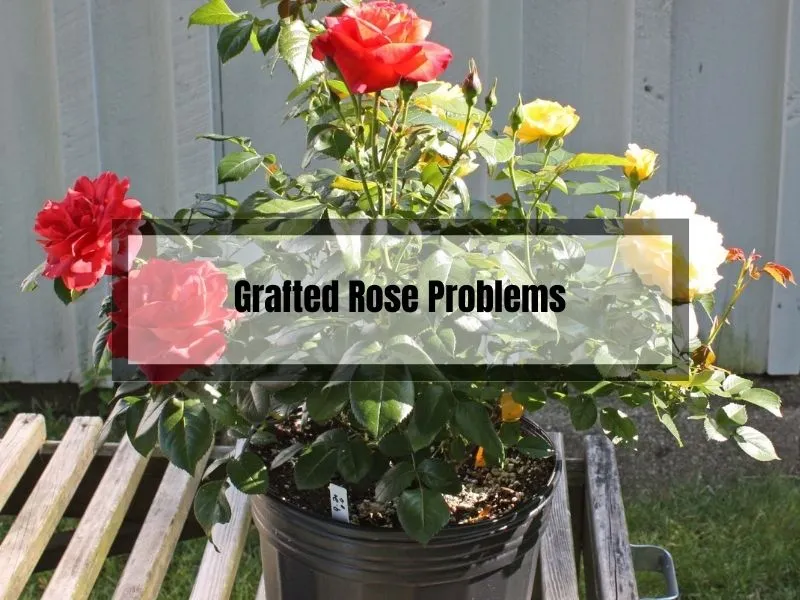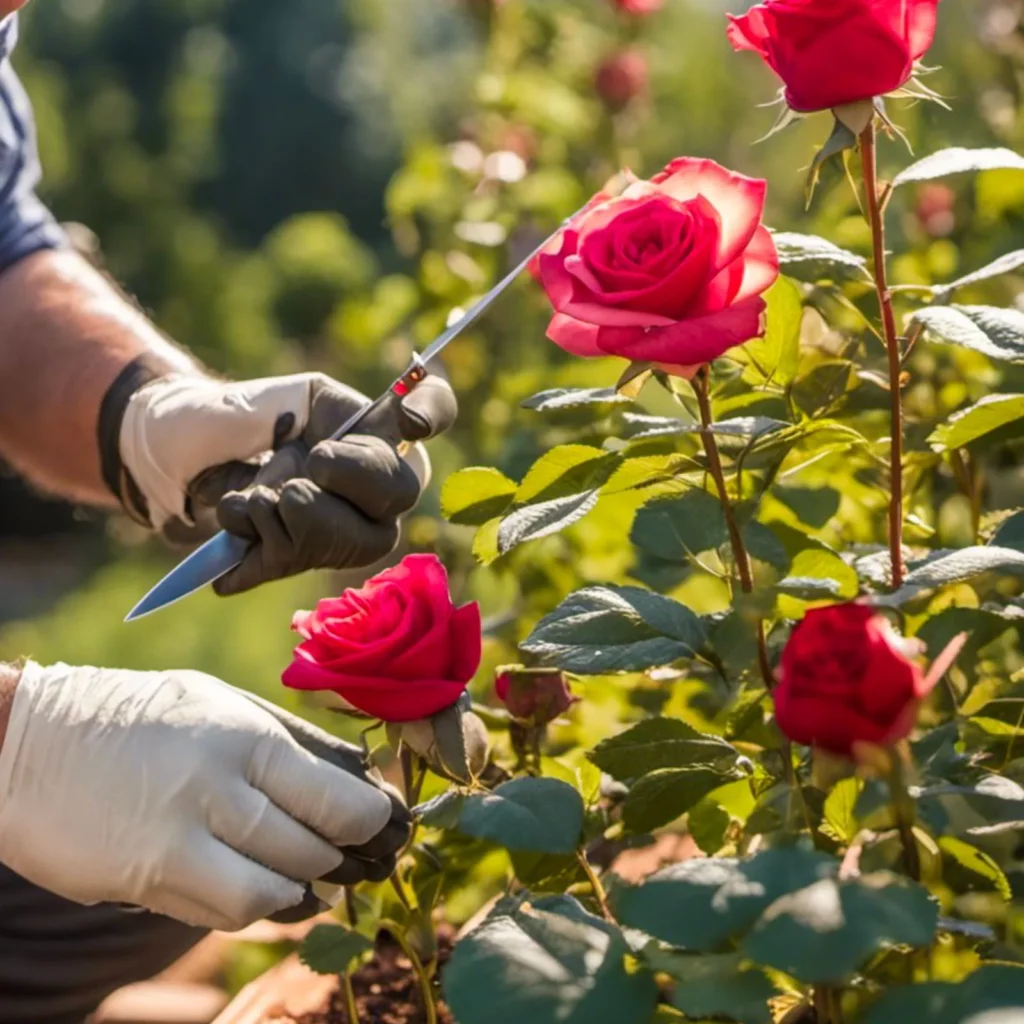Grafted Rose Problems: How to Identify and Address Them
If you’re a rose enthusiast, you know the satisfaction of seeing your garden in full bloom. However, grafted roses can sometimes encounter problems. In this article, we’ll discuss grafted rose issues, their causes, symptoms, prevention, and treatment.
Grafted roses result from joining two different rose plants, one as the rootstock and the other as the scion. This technique allows gardeners to combine desirable traits from different roses into one plant.
However, grafted roses can be weaker at the graft point, making them more susceptible to issues like weakness at the graft point, winter loss, diseases, and pests.
Key Takeaways
- Grafted roses are created by joining two different rose plants together.
- Common problems with grafted roses include weakness at the point of the graft, winter loss, and susceptibility to diseases and pests.
- To prevent and treat grafted rose problems, it’s important to choose the right rootstock, plant the rose properly, and provide adequate care and maintenance.

Grafted Rose Problems
Grafted roses are a beautiful addition to any garden, but they do come with their own set of problems. Here are some of the most common issues that gardeners face when growing grafted roses:
- Weakness at the point of the graft: One of the biggest problems with grafted roses is that they can be relatively weak at the graft point. This means that the top part of the rose, which is the part that produces the flowers, can break off easily. This is especially true if the rose is exposed to strong winds or heavy rain. To prevent this from happening, it’s important to stake the rose and provide support until it becomes stronger.
- Suckers: Another common problem with grafted roses is the appearance of suckers. These are shoots that grow from the rootstock, which is the part of the rose that the top part is grafted onto. Suckers can be identified by their different leaves and growth habit. They are usually more vigorous than the top part of the rose and can take over the entire plant if left unchecked. To prevent suckers from taking over, it’s important to prune them off as soon as they appear.
- Disease: Grafted roses are more susceptible to disease than own-root roses. This is because the rootstock can be more susceptible to disease than the top part of the rose. Common diseases that affect grafted roses include black spot, powdery mildew, and rust. To prevent disease from taking hold, it’s important to keep the rose healthy by providing it with adequate water, nutrients, and sunlight.
- Rootstock takeover: Sometimes, the rootstock can take over the top part of the rose. This can happen if the top part of the rose dies or is damaged. The rootstock will then send up new shoots, which will grow into a new rose. To prevent this from happening, it’s important to keep the top part of the rose healthy and to prune off any dead or damaged parts.
Causes of Graft Failure
Grafted roses can be an excellent way to get the best of both worlds. You can combine the hardiness of one plant with the beauty of another.
Unfortunately, grafting is not always successful. Here are some of the most common causes of graft failure:
Graft Incompatibility
One of the most common causes of graft failure is incompatibility between the rootstock and the scion.
This can happen when the two plants are too different genetically. When this happens, the graft union may not be able to form properly, and the plant will eventually die.
Improper Technique
Another common cause of graft failure is improper technique. If the graft is not done correctly, the two plants may not be able to grow together properly. This can lead to a weak graft union that is more likely to break or fail.
Environmental Factors
Environmental factors can also play a role in graft failure. If the plant is exposed to extreme temperatures or poor soil conditions, it may not be able to grow properly. This can weaken the graft union and make it more likely to fail.
Disease
Disease can also be a factor in graft failure. If the plant is infected with a disease, it may not be able to grow properly, and the graft union may not be able to form properly. This can lead to a weak graft union that is more likely to fail.
Physical Damage
Physical damage can also cause graft failure. If the plant is damaged during the grafting process or after it has been planted, it may not be able to grow properly. This can weaken the graft union and make it more likely to fail.
We have had experience with graft failure in our own garden. We once tried to graft a rose onto a rootstock that was not compatible with it, and the graft failed. We learned that it is important to choose the right rootstock for the scion and to use proper grafting techniques to ensure a successful graft.
Symptoms of Graft Failure
Graft failure in roses can be a frustrating problem for gardeners. It can occur in both young and established plants, and symptoms may not be visible until it’s too late. Here are some of the common symptoms of graft failure in roses:
- Shoot dieback: One of the most common symptoms of graft failure is shoot dieback. This occurs when the shoots of the plant start to die from the tips back towards the base. This can be caused by a lack of water, nutrients, or oxygen reaching the shoots due to a failed graft union.
- Yellowing foliage: Another symptom of graft failure is yellowing foliage. This can be caused by a lack of nutrients reaching the leaves due to a failed graft union.
- Smooth, clean breaking off of the tree at the graft union: The most pronounced symptom of graft failure is a smooth, clean breaking off of the tree at the graft union. This may occur one, two, or many years after the graft is made.
- Poor growth: Graft failure can also cause poor growth in the affected plant. The plant may start showing signs of gradual deterioration, or the demise can be quite sudden.
- Bulges at the graft union: In some cases, the graft union may show signs of bulges or other deformities. This can be a sign of incompatibility between the scion and rootstock.
If you notice any of these symptoms in your grafted roses, it’s important to take action as soon as possible to prevent further damage.
Preventing Graft Failure
When it comes to grafted roses, one of the biggest concerns is graft failure. Fortunately, there are several steps you can take to minimize the risk of graft failure and ensure that your roses thrive.
Choose Compatible Plants
Selecting compatible plants is essential to prevent graft failure. Research and choose rootstock and scion combinations that are known to be compatible. This will increase the chances of a successful graft and reduce the risk of graft failure.
Graft at the Right Time
Grafting at the right time is crucial for successful grafting. The best time to graft depends on the specific plants you are working with.
Some plants are best grafted in the spring, while others are best grafted in the fall. Make sure to research the ideal grafting time for your specific plants to increase the chances of success.
Use Proper Techniques
Using proper grafting techniques is vital to prevent graft failure. Learning and employing proper grafting techniques, including clean cuts and proper alignment, can help increase the chances of a successful graft.
Make sure to use sharp, sterilized tools and follow proper grafting procedures to prevent infection and ensure a successful graft.
Monitor for Signs of Graft Failure
Even with the best precautions, graft failure can still occur. It is essential to monitor your grafted roses for signs of graft failure, such as a smooth, clean breaking off of the tree at the graft union or general ill health of the tree. If you notice any signs of graft failure, take immediate action to address the issue.
By following these steps, you can minimize the risk of graft failure and help ensure that your grafted roses thrive. Remember to choose compatible plants, graft at the right time, use proper techniques, and monitor for signs of graft failure to increase the chances of a successful graft.
Treatment for Graft Failure
Graft failure is a common problem with grafted roses. It occurs when the grafted portion of the plant dies, leaving only the rootstock to grow. Here are some treatment options for graft failure:
Re-transplantation
Re-transplantation from another donor or the same donor is the treatment of choice for patients with primary graft failure or acute graft rejection. In the case of roses, re-grafting is possible if the rootstock is still healthy.
The process involves cutting the rose stem and inserting a new bud from the desired species into the rootstock. This method is effective, but it requires skill and experience.
Pruning
Pruning the rootstock is another way to control its growth and prevent it from taking over the plant.
To do this, simply cut away any roots that are growing outside of the planting hole. This will help keep the rootstock in check and allow the grafted portion of the plant to thrive.
Prevention
Preventing graft failure is the best way to deal with the problem. Here are some tips to avoid graft failure:
- Choose healthy rootstock and scion wood.
- Make sure the graft union is well-healed before planting.
- Protect the graft union from extreme temperatures, pests, and diseases.
- Water and fertilize the plant properly.
By following these tips, you can reduce the risk of graft failure and enjoy healthy, beautiful roses.
Graft failure can be frustrating, but it is not the end of the world. With the right treatment and prevention methods, you can keep your grafted roses healthy and thriving.
How to Care for Grafted Roses

If you already have grafted roses or decide to get one, here are some tips to help you take care of them:
Planting Depth
Planting the graft union below the soil level is crucial. Aim for at least one or two inches below the soil. If you’re in zones 4 or colder, you might even want to go deeper.
This helps protect the graft from the elements and gives your rose the best chance of survival.
Winter Protection
Cold winters can be tough on grafted roses, especially tender hybrids. To protect your roses during the winter, consider using the Minnesota Tip method. This involves digging a trench and laying the entire plant down inside it, then covering it with soil.
It might sound like overkill, but it works! Alternatively, you can explore other methods to shield your roses from harsh winters.
Sucker Management
Remember those pesky rootstock suckers we mentioned earlier? Here’s how to deal with them. First, learn to identify them. Rootstock suckers might look a bit different from the grafted rose canes.
Gently remove the soil around the base to see if the sucker is coming from below or above the graft union.
When you find rootstock suckers, it’s essential to remove them carefully. Don’t just prune them off, as this can encourage the growth of even more suckers. Instead, with the soil removed, grasp the sucker at the base and pull it down and away from the root. This way, you’ll minimize the chances of a sucker invasion.
Frequently Asked Questions (FAQs)
To make your life a little easier, I’ve answered some common questions about grafted roses below:
Are grafted roses weaker than own-root roses?
In some ways, yes. Grafted roses can be weaker at the graft point and have a shorter life expectancy compared to own-root roses. However, with proper care, grafted roses can still thrive in your garden.
What are the benefits of grafting roses?
Grafting is a fast and easy way to propagate roses, which is why many nurseries use this method. Grafted roses can also benefit from the rootstock’s vigor and resistance to diseases, depending on the specific rootstock used.
Can grafted roses revert back to their original variety?
No, grafted roses won’t revert to their original variety. However, if the grafted part dies and the rootstock takes over, the plant will show the characteristics of the rootstock variety.
How do I know if my rose is grafted or own-root?
Look for a swollen or knobby section near the base of the plant. This is the graft union, where the desired rose variety was grafted onto the rootstock. If you can’t find a graft union, it’s likely that you have an own-root rose.
Is it possible to prevent rootstock suckers from growing?
While it’s challenging to prevent rootstock suckers completely, you can minimize their growth by planting the graft union below the soil level and regularly inspecting your plant for any new suckers. Removing them promptly will help keep them under control.
Conclusion
And there you have it! Grafted roses can be beautiful additions to your garden, but they do come with their fair share of challenges. By understanding the common problems associated with grafted roses and practicing proper care and maintenance, you can maximize their lifespan and enjoy their blooms for years to come.
Don’t forget that purchasing own-root roses when possible is always a good idea to avoid these issues. But if you do choose to grow grafted roses, just be prepared to give them the extra love and attention they deserve. Happy gardening!
Related Posts:






